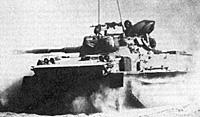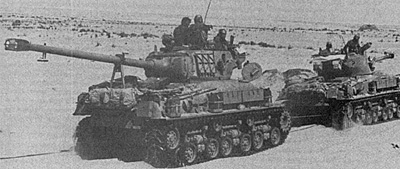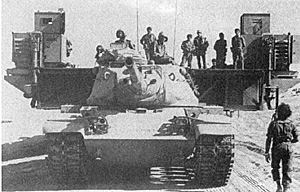 In my first article I covered the army, reconnaissance, and infantry forces of the Israeli Defense Force (IDF) and the Egyptians. In this portion I will start to address some of the supporting forces.
In my first article I covered the army, reconnaissance, and infantry forces of the Israeli Defense Force (IDF) and the Egyptians. In this portion I will start to address some of the supporting forces.
Artillery
It should come as no surprise that the Egyptian artillery was Soviet supplied and organized along Soviet lines. Divisional artillery units for the Egyptians have been incorporated into the combat factors of the supported divisional units. Under Soviet-style command and control structures, these units would not have been able to support any other division; thus it is historically accurate to incorporate their strength into the divisional units. Israeli brigade- and divisional-level artillery units are all incorporated into the artillery brigades. Given the great flexibility with which the IDF operated, Israeli artillery could quickly shift fire as necessary.
Most Egyptian artillery tended to be towed, while most Israeli artillery was self propelled. This is very illustrative of the differing strategies between the opposing forces. The Egyptians planned to fight a set piece battle along the canal and towed weapons suited their style and technical abilities well (towed artillery is much easier to maintain than self propelled guns). The Israelis planned a fluid, mobile action quickly moving over to the offensive, so they desired that their artillery be able to keep pace with rapidly moving armored columns. Additionally, the average IDF soldier was better educated and was better suited to maintain and use the self-propelled guns.
Egyptian artillery brigades were composed of three battalions of 12 guns each. The Egyptian army held 122mm, 130mm, 152mm and 180mm towed artillery pieces as well as Katyusha rockets. The Egyptian "FROG" brigade was supplied with Soviet supplied Free Rocket Over Ground 7 (FROG-7) missiles, which, along with SCUD-B missiles, were supplied to Egypt to counter the Israeli Air Force's deep strike threat. The theory here was that these missiles would provide the Egyptians with a deep strike capability of their own.
Israeli artillery units were equipped with a varied art ay of equipment ranging from homemade weapons to captured equipment. Israeli industry produced the M-50 and the L-33 self- propelled artillery pieces both with a 155mm gun mounted on a Sherman chassis. The M-50 had an open chassis while the L-33 was enclosed. M- 109 155mm, M- 107 175mm and some M- 110 203mm self-propelled guns were supplied by the Americans and used extensively. Additionally, 120mm and 160mm self-propelled mortars were mounted on M-3 halftracks and the ubiquitous (in at least the IDF) Sherman chassis. These weapons provided the IDF with battalionlevel support. The towed artillery unit (artillery unit #5) was equipped with American towed 155 mm guns and captured 122mm and 130mm guns, and the "Rckt" unit was supplied with captured Katyushas. Lance rockets were also available to the IDF although to the best of my knowledge not used. The Israelis greatly appreciated the D-30 122mm towed gun, which was an excellent weapon.
Generally, both Israeli and Egyptian artillery performance could be characterized as mediocre at best. Both sides expended large amounts of ammunition on poorly directed harassment and interdiction fire. Counter battery fire was largely ineffective (despite a picture, which appears in almost every book dealing with the war, which shows an IDF M- 107 destroyed by counter battery fire), and crews were slow to change their fire positions. Incidentally Saddam Hussein would, I'm sure, be upset to learn that the Egyptians were the first to use SCUD missiles against Israel. On October 22nd the Egyptians fired a single missile into the Sinai chiefly to send a political message to the Israelis.
Engineers
 In few conflicts of the 20th century have engineers
played as vital and pivotal a role as they did in the October War.
Crossing a water barrier is one of the most difficult military
undertakings, and both sides came up with unique methods to solve the
dilemma posed by the Suez Canal.
In few conflicts of the 20th century have engineers
played as vital and pivotal a role as they did in the October War.
Crossing a water barrier is one of the most difficult military
undertakings, and both sides came up with unique methods to solve the
dilemma posed by the Suez Canal.
Before I address the engineering troops, it would be prudent to consider the unique environment of the canal. The Suez Canal was constructed taking the maximum advantage of the pre-existing Bitter Lakes and extends 175 kilometers from Port Said on the Mediterranean Sea to Suez City on the Gulf of Suez. The canal varies in width from 180 to 220 meters, is 16 to 18 meters deep and is not fordable at any point.
When the canal was dug out the sand was deposited along the banks, producing an embankment along the canal. This berm was subsequently built up by both sides and fortifications were constructed along it (by both sides, with the Bar-Lev Forts being best known). The embankment along the east (Israeli) bank of the canal rose to a height of 20 meters and was 10 meters thick. Also, its 45 degree slope ensured that amphibious vehicles could not climb it. The IDF calculated it would take the Egyptians one and a half to two days to cut through this imposing barrier.
Crossing the Canal and embankment was the task to which some 15,000 Egyptian engineering troops in 80 company- and battalion-sized units were dedicated. They, and their Israeli counterparts, devised some amazing solutions in resolving the crossing problem.
Egyptian engineers were equipped with Soviet-produced BTR-50 APCs, T-54 tanks with "Mine Harrows," GSP ferries, PMP and TPP (Heavy Pontoon) bridges and Infantry Bridges. As the fourth wave of infantry crossed the canal, the engineers crossed in rubber boats. They immediately employed powerful water pumps to eat away at the sand embankments, creating gaps in the berm (in some writings these gaps are called "Cuts"). These gaps would be used as terminus points for ferries and bridges, and a total of 82 would be cut out by the end of the war. Instead of two days, some gaps were cut in only two hours, enabling the next phase of the crossing operation to proceed.
Next the Egyptians began to ferry the infantry over in BTR-50s and 60s and the tanks on GSP ferries. The first night, the engineers began the construction of the bridges. Infantry bridges were constructed of interlocking sections of 3 meter long 2 x 4 planks laid on pontoons and were easily constructed. Each infantry division had four heavy bridges assigned to it with two each of the PMP and TPP type bridges. These bridges were generally in operation by H+ 6 to 9 hours, quite a shock to the Israelis.
Despite Israeli attempts to destroy them, no bridge was permanently knocked out during the war. This is a testament to the basic Soviet bridge design and the Egyptian engineering efforts. Many engineering troops of both sides lost their lives during the war, and Egypt quickly suffered the loss of Brigadier Hawdi, the Third Army's Engineering Officer, to IDF 175mm guns early in the crossing operation.
The Israelis also planned to cross the canal and take the war to "Africa" as they called Egypt. Under General "Arik" Sharon, the previous Southern Command commander, the IDFbegan to construct an infrastructure along the canal for a crossing operation. The IDF faced a quite different situation than the Egyptians. Soon after the 1967 war the Israelis began to search for a supplier of bridging equipment; however, no country would sell them any.
The IDF solved the problem in a uniquely Israeli fashion. They salvaged 18 old Gilowa amphibious vehicles and when three of these were joined they could ferry a MBT. These Gilowas provided the IDF with six ferries which could transport themselves to the canal. They then bought "Unifloat Cubes"; when several cubes were joined and fitted with an engine they would create a raft or ferry which could carry two MBTs each. These rafts were constructed at a distance from the canal and were then towed by one MBT each to the canal. The rafts were bulky and caused traffic jams as they moved toward the canal. Later the rafts would be linked together in the canal to become a bridge.
 A unique Israeli solution was to build a "Roller Bridge"
or "Preconstructed Bridge" (PCB) and roll it down to the canal.
Three ruler-straight roads were built in the Sinai and the bridge would
be moved from Tasa to the eastern end of the chosen roadway and
assembled. A platoon of MBTs would then be linked to the bridge and
would tow it to the canal. At the canal the bridge would be rolled into
the canal and to the opposite bank, creating an instant bridge.
A unique Israeli solution was to build a "Roller Bridge"
or "Preconstructed Bridge" (PCB) and roll it down to the canal.
Three ruler-straight roads were built in the Sinai and the bridge would
be moved from Tasa to the eastern end of the chosen roadway and
assembled. A platoon of MBTs would then be linked to the bridge and
would tow it to the canal. At the canal the bridge would be rolled into
the canal and to the opposite bank, creating an instant bridge.
What sounded good in theory was much more difficult in practice. The bridge and its entourage of support vehicles blocked the roadway for a day, the bridge broke down frequently, and at one it point broke free of the tanks and rolled down a hill. The bridge arrived at the canal far behind schedule, but performed well once in place.
In the rules the engineering counters "convert" into bridges. This may at first seem strange, but one aspect of bridging operations that most wargames fail to model is the sheer numbers of men it takes to maintain and run the bridges even once they are in place. The troops don't just disappear, but rather are engaged in supporting the crossing operations (both men and supplies).
More Weapons
-
Part 1: Armored, Infantry, and Recon Units
Part 2: Artillery and Engineers
Part 3: Air Forces, SAMs, and the Superpowers
Back to Table of Contents -- Operations #19
Back to Operations List of Issues
Back to MagWeb Master List of Magazines
© Copyright 1995 by The Gamers.
This article appears in MagWeb (Magazine Web) on the Internet World Wide Web.
Other military history articles and gaming articles are available at http://www.magweb.com